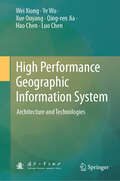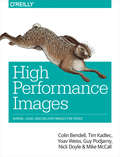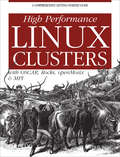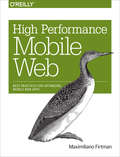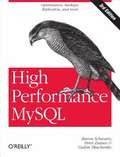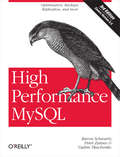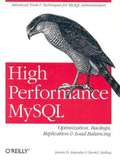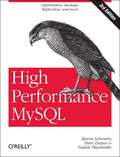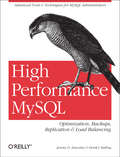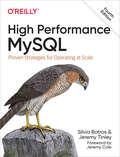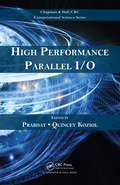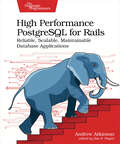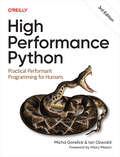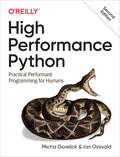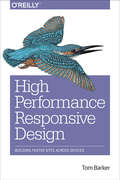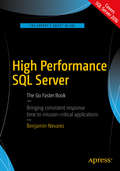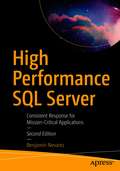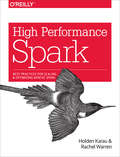- Table View
- List View
High Performance Geographic Information System: Architecture and Technologies
by Wei Xiong Hao Chen Ye Wu Xue Ouyang Qing-ren Jia Luo ChenThe development of earth observation and computing technology has promoted the wide application of spatio-temporal big data and artificial intelligence. The enrichment of data and the improvement of computational performance make it possible to perform spatio-temporal analysis and computation on a larger scale. Therefore, it is necessary to study the optimization methods and application methods of high-performance geocomputing, starting from GIS architecture, in order to form a high-performance GIS that can serve the society and economy and support various applications. This book focuses on the architecture, technology, platform, and application of high-performance GIS, analyzes the key technologies of spatio-temporal big data organization and access, parallelized spatial analysis and processing, large-scale map rendering, and parallel visualization under the high-performance computing architecture, explains how to build high-performance geographic information applications, and looks forward to the trend of the new generation of GIS.
High Performance Images: Shrink, Load, and Deliver Images for Speed
by Guy Podjarny Nick Doyle Tim Kadlec Colin Bendell Yoav Weiss Mike McCallHigh-quality images have an amazing power of attraction. Just add some stunning photos and graphics to your website or app and watch your user engagement and conversion numbers climb. It can be tricky, but with this practical guide, you’ll master the many facets of delivering high performance images on the internet—without adversely affecting site performance.You’ll learn the nuts and bolts of color theory, image formats, storage and management, operations delivery, browser and application behavior, the responsive web, and many other topics. Ideal for developers, this book also provides useful tips, tricks, and practical theory for processing and displaying powerful images that won’t slow down your online product.Explore digital image theory and the different formats availableDive into JPEGs, SVG and vector images, lossless compression, and other formatsUse techniques for downloading and rendering images in a browser, and for loading images on mobile devices and cellular networksExamine specific rendering techniques, such as lazy loading, image processing, image consolidation, and responsive imagesTake responsive images to the next level by using content negotiation between browser and server with the Client Hints HTTP standardLearn how to operationalize your image workflowContributors include Colin Bendell, Tim Kadlec, Yoav Weiss, Guy Podjarny, Nick Doyle, and Mike McCall from Akamai Technologies.
High Performance Integer Arithmetic Circuit Design on FPGA
by Ayan Palchaudhuri Rajat Subhra ChakrabortyThis book describes the optimized implementations of several arithmetic datapath, controlpath and pseudorandom sequence generator circuits for realization of high performance arithmetic circuits targeted towards a specific family of the high-end Field Programmable Gate Arrays (FPGAs). It explores regular, modular, cascadable and bit-sliced architectures of these circuits, by directly instantiating the target FPGA-specific primitives in the HDL. Every proposed architecture is justified with detailed mathematical analyses. Simultaneously, constrained placement of the circuit building blocks is performed, by placing the logically related hardware primitives in close proximity to one another by supplying relevant placement constraints in the Xilinx proprietary "User Constraints File". The book covers the implementation of a GUI-based CAD tool named FlexiCore integrated with the Xilinx Integrated Software Environment (ISE) for design automation of platform-specific high-performance arithmetic circuits from user-level specifications. This tool has been used to implement the proposed circuits, as well as hardware implementations of integer arithmetic algorithms where several of the proposed circuits are used as building blocks. Implementation results demonstrate higher performance and superior operand-width scalability for the proposed circuits, with respect to implementations derived through other existing approaches. This book will prove useful to researchers, students and professionals engaged in the domain of FPGA circuit optimization and implementation.
High Performance JavaScript: Build Faster Web Application Interfaces
by Nicholas C. ZakasIf you're like most developers, you rely heavily on JavaScript to build interactive and quick-responding web applications. The problem is that all of those lines of JavaScript code can slow down your apps. This book reveals techniques and strategies to help you eliminate performance bottlenecks during development. You'll learn how to improve execution time, downloading, interaction with the DOM, page life cycle, and more.Yahoo! frontend engineer Nicholas C. Zakas and five other JavaScript experts—Ross Harmes, Julien Lecomte, Steven Levithan, Stoyan Stefanov, and Matt Sweeney—demonstrate optimal ways to load code onto a page, and offer programming tips to help your JavaScript run as efficiently and quickly as possible. You'll learn the best practices to build and deploy your files to a production environment, and tools that can help you find problems once your site goes live.Identify problem code and use faster alternatives to accomplish the same taskImprove scripts by learning how JavaScript stores and accesses dataImplement JavaScript code so that it doesn't slow down interaction with the DOMUse optimization techniques to improve runtime performanceLearn ways to ensure the UI is responsive at all timesAchieve faster client-server communicationUse a build system to minify files, and HTTP compression to deliver them to the browser
High Performance Linux Clusters with OSCAR, Rocks, OpenMosix, and MPI: A Comprehensive Getting-Started Guide
by Joseph D SloanTo the outside world, a "supercomputer" appears to be a single system. In fact, it's a cluster of computers that share a local area network and have the ability to work together on a single problem as a team. Many businesses used to consider supercomputing beyond the reach of their budgets, but new Linux applications have made high-performance clusters more affordable than ever. These days, the promise of low-cost supercomputing is one of the main reasons many businesses choose Linux over other operating systems.This new guide covers everything a newcomer to clustering will need to plan, build, and deploy a high-performance Linux cluster. The book focuses on clustering for high-performance computation, although much of its information also applies to clustering for high-availability (failover and disaster recovery). The book discusses the key tools you'll need to get started, including good practices to use while exploring the tools and growing a system. You'll learn about planning, hardware choices, bulk installation of Linux on multiple systems, and other basic considerations. Then, you'll learn about software options that can save you hours--or even weeks--of deployment time.Since a wide variety of options exist in each area of clustering software, the author discusses the pros and cons of the major free software projects and chooses those that are most likely to be helpful to new cluster administrators and programmers. A few of the projects introduced in the book include:MPI, the most popular programming library for clusters. This book offers simple but realistic introductory examples along with some pointers for advanced use.OSCAR and Rocks, two comprehensive installation and administrative systemsopenMosix (a convenient tool for distributing jobs), Linux kernel extensions that migrate processes transparently for load balancingPVFS, one of the parallel filesystems that make clustering I/O easierC3, a set of commands for administering multiple systemsGanglia, OpenPBS, and cloning tools (Kickstart, SIS and G4U) are also covered. The book looks at cluster installation packages (OSCAR & Rocks) and then considers the core packages individually for greater depth or for folks wishing to do a custom installation. Guidelines for debugging, profiling, performance tuning, and managing jobs from multiple users round out this immensely useful book.
High Performance Mobile Web: Best Practices for Optimizing Mobile Web Apps
by Maximiliano FirtmanOptimize the performance of your mobile websites and webapps to the extreme. With this hands-on book, veteran mobile and web developer Maximiliano Firtman demonstrates which aspects of your site or app slow down the user’s experience, and what you can do to achieve lightning-fast performance. There’s much at stake: if you want to boost your app’s conversion rate, then tackling performance issues is the best way to start.Learn tools and techniques for working with responsive web design, images, the network layer, and many other ingredients—plus the metrics to check your progress. Ideal for web developers and web designers with HTML, CSS, JavaScript, and HTTP experience, this is your guide to superior mobile web performance.You’ll dive into:Emulators, simulators, and other tools for measuring performanceBasic web performance concepts, including metrics, charts, and goalsHow to get real data from mobile browsers on your real networksAPIs and specs for measuring, tracking and improving web performanceInsights and tricks for optimizing the first view experienceWays to optimize post-loading experiences and future visitsResponsive web design and its performance challengesTips for extreme performance to achieve best conversion ratesHow to work with web views inside native apps
High Performance MySQL
by Derek J. Balling Jeremy Zawodny Baron Schwartz Peter Zaitsev Vadim Tkachenko Arjen LentzHigh Performance MySQL is the definitive guide to building fast, reliable systems with MySQL. Written by noted experts with years of real-world experience building very large systems, this book covers every aspect of MySQL performance in detail, and focuses on robustness, security, and data integrity. High Performance MySQL teaches you advanced techniques in depth so you can bring out MySQL's full power. Learn how to design schemas, indexes, queries and advanced MySQL features for maximum performance, and get detailed guidance for tuning your MySQL server, operating system, and hardware to their fullest potential. You'll also learn practical, safe, high-performance ways to scale your applications with replication, load balancing, high availability, and failover. This second edition is completely revised and greatly expanded, with deeper coverage in all areas. Major additions include: * Emphasis throughout on both performance and reliability * Thorough coverage of storage engines, including in-depth tuning and optimizations for the InnoDB storage engine * Effects of new features in MySQL 5.0 and 5.1, including stored procedures, partitioned databases, triggers, and views * A detailed discussion on how to build very large, highly scalable systems with MySQL * New options for backups and replication * Optimization of advanced querying features, such as full-text searches * Four new appendices The book also includes chapters on benchmarking, profiling, backups, security, and tools and techniques to help you measure, monitor, and manage your MySQL installations.
High Performance MySQL
by Derek J. Balling Baron Schwartz Peter Zaitsev Vadim Tkachenko Arjen Lentz Jeremy D. ZawodnyHigh Performance MySQL is the definitive guide to building fast, reliable systems with MySQL. Written by noted experts with years of real-world experience building very large systems, this book covers every aspect of MySQL performance in detail, and focuses on robustness, security, and data integrity.High Performance MySQL teaches you advanced techniques in depth so you can bring out MySQL's full power. Learn how to design schemas, indexes, queries and advanced MySQL features for maximum performance, and get detailed guidance for tuning your MySQL server, operating system, and hardware to their fullest potential. You'll also learn practical, safe, high-performance ways to scale your applications with replication, load balancing, high availability, and failover. This second edition is completely revised and greatly expanded, with deeper coverage in all areas. Major additions include:Emphasis throughout on both performance and reliability Thorough coverage of storage engines, including in-depth tuning and optimizations for the InnoDB storage engine Effects of new features in MySQL 5.0 and 5.1, including stored procedures, partitioned databases, triggers, and views A detailed discussion on how to build very large, highly scalable systems with MySQL New options for backups and replication Optimization of advanced querying features, such as full-text searches Four new appendices The book also includes chapters on benchmarking, profiling, backups, security, and tools and techniques to help you measure, monitor, and manage your MySQL installations.
High Performance MySQL
by Baron Schwartz Peter Zaitsev Vadim Tkachenko<p><i>High Performance MySQL</i> teaches you advanced techniques in depth so you can bring out MySQL's full power. Learn how to design schemas, indexes, queries, and advanced MySQL features for maximum performance, and get detailed guidance for tuning your MySQL server, operating system, and hardware to their fullest potential. You'll also learn practical, safe, high-performance ways to scale your applications with replication, load balancing, high availability, and failover.</p>
High Performance MySQL
by Derek J. Balling Jeremy ZawodnyIn High Performance MySQL you will learn about MySQL indexing and optimization in depth so you can make better use of these key features. You will learn practical replication, backup, and load-balancing strategies with information that goes beyond available tools to discuss their effects in real-life environments. And you'll learn the supporting techniques you need to carry out these tasks, including advanced configuration, benchmarking, and investigating logs.
High Performance MySQL, 2nd Edition
by Derek J. Balling Jeremy Zawodny Baron Schwartz Peter Zaitsev Vadim Tkachenko Arjen LentzHigh Performance MySQL is the definitive guide to building fast, reliable systems with MySQL. Written by noted experts with years of real-world experience building very large systems, this book covers every aspect of MySQL performance in detail, and focuses on robustness, security, and data integrity. High Performance MySQL teaches you advanced techniques in depth so you can bring out MySQL's full power. Learn how to design schemas, indexes, queries and advanced MySQL features for maximum performance, and get detailed guidance for tuning your MySQL server, operating system, and hardware to their fullest potential. You'll also learn practical, safe, high-performance ways to scale your applications with replication, load balancing, high availability, and failover. This second edition is completely revised and greatly expanded, with deeper coverage in all areas. Major additions include: Emphasis throughout on both performance and reliability Thorough coverage of storage engines, including in-depth tuning and optimizations for the InnoDB storage engine Effects of new features in MySQL 5.0 and 5.1, including stored procedures, partitioned databases, triggers, and views A detailed discussion on how to build very large, highly scalable systems with MySQL New options for backups and replication Optimization of advanced querying features, such as full-text searches Four new appendices The book also includes chapters on benchmarking, profiling, backups, security, and tools and techniques to help you measure, monitor, and manage your MySQL installations.
High Performance MySQL, 2nd Edition
by Jeremy Zawodny Baron Schwartz Peter Zaitsev Vadim TkachenkoHigh Performance MySQL is the definitive guide to building fast, reliable systems with MySQL. Written by noted experts with years of real-world experience building very large systems, this book covers every aspect of MySQL performance in detail, and focuses on robustness, security, and data integrity. High Performance MySQL teaches you advanced techniques in depth so you can bring out MySQL's full power. Learn how to design schemas, indexes, queries and advanced MySQL features for maximum performance, and get detailed guidance for tuning your MySQL server, operating system, and hardware to their fullest potential. You'll also learn practical, safe, high-performance ways to scale your applications with replication, load balancing, high availability, and failover. This second edition is completely revised and greatly expanded, with deeper coverage in all areas. Major additions include: * Emphasis throughout on both performance and reliability * Thorough coverage of storage engines, including in-depth tuning and optimizations for the InnoDB storage engine * Effects of new features in MySQL 5.0 and 5.1, including stored procedures, partitioned databases, triggers, and views * A detailed discussion on how to build very large, highly scalable systems with MySQL * New options for backups and replication * Optimization of advanced querying features, such as full-text searches * Four new appendices The book also includes chapters on benchmarking, profiling, backups, security, and tools and techniques to help you measure, monitor, and manage your MySQL installations.
High Performance MySQL: Optimization, Backups, Replication, Load Balancing & More
by Derek J. Balling Jeremy D. ZawodnyAs users come to depend on MySQL, they find that they have to deal with issues of reliability, scalability, and performance--issues that are not well documented but are critical to a smoothly functioning site. This book is an insider's guide to these little understood topics.Author Jeremy Zawodny has managed large numbers of MySQL servers for mission-critical work at Yahoo!, maintained years of contacts with the MySQL AB team, and presents regularly at conferences. Jeremy and Derek have spent months experimenting, interviewing major users of MySQL, talking to MySQL AB, benchmarking, and writing some of their own tools in order to produce the information in this book.In High Performance MySQL you will learn about MySQL indexing and optimization in depth so you can make better use of these key features. You will learn practical replication, backup, and load-balancing strategies with information that goes beyond available tools to discuss their effects in real-life environments. And you'll learn the supporting techniques you need to carry out these tasks, including advanced configuration, benchmarking, and investigating logs.Topics include:A review of configuration and setup optionsStorage engines and table typesBenchmarkingIndexesQuery OptimizationApplication DesignServer PerformanceReplicationLoad-balancingBackup and RecoverySecurity
High Performance MySQL: Optimization, Backups, and Replication
by Baron Schwartz Peter Zaitsev Vadim TkachenkoHow can you bring out MySQL’s full power? With High Performance MySQL, you’ll learn advanced techniques for everything from designing schemas, indexes, and queries to tuning your MySQL server, operating system, and hardware to their fullest potential. This guide also teaches you safe and practical ways to scale applications through replication, load balancing, high availability, and failover.Updated to reflect recent advances in MySQL and InnoDB performance, features, and tools, this third edition not only offers specific examples of how MySQL works, it also teaches you why this system works as it does, with illustrative stories and case studies that demonstrate MySQL’s principles in action. With this book, you’ll learn how to think in MySQL.Learn the effects of new features in MySQL 5.5, including stored procedures, partitioned databases, triggers, and viewsImplement improvements in replication, high availability, and clusteringAchieve high performance when running MySQL in the cloudOptimize advanced querying features, such as full-text searchesTake advantage of modern multi-core CPUs and solid-state disksExplore backup and recovery strategies—including new tools for hot online backups
High Performance MySQL: Proven Strategies for Operating at Scale
by Silvia Botros Jeremy TinleyHow can you realize MySQL's full power? With High Performance MySQL, you'll learn advanced techniques for everything from setting service-level objectives to designing schemas, indexes, and queries to tuning your server, operating system, and hardware to achieve your platform's full potential. This guide also teaches database administrators safe and practical ways to scale applications through replication, load balancing, high availability, and failover.Updated to reflect recent advances in cloud- and self-hosted MySQL, InnoDB performance, and new features and tools, this revised edition helps you design a relational data platform that will scale with your business. You'll learn best practices for database security along with hard-earned lessons in both performance and database stability.Dive into MySQL's architecture, including key facts about its storage enginesLearn how server configuration works with your hardware and deployment choicesMake query performance part of your software delivery processExamine enhancements to MySQL's replication and high availabilityCompare different MySQL offerings in managed cloud environmentsExplore MySQL's full stack optimization from application-side configuration to server tuningTurn traditional database management tasks into automated processes
High Performance Parallel I/O
by Prabhat Quincey KoziolGain Critical Insight into the Parallel I/O EcosystemParallel I/O is an integral component of modern high performance computing (HPC), especially in storing and processing very large datasets to facilitate scientific discovery. Revealing the state of the art in this field, High Performance Parallel I/O draws on insights from leading practitioners,
High Performance PostgreSQL for Rails: Reliable, Scalable, Maintainable Database Applications
by Andrew AtkinsonBuild faster, more reliable Rails apps by taking the best advanced PostgreSQL and Active Record capabilities, and using them to solve your application scale and growth challenges. Gain the skills needed to comfortably work with multi-terabyte databases, and with complex Active Record, SQL, and specialized Indexes. Develop your skills with PostgreSQL on your laptop, then take them into production, while keeping everything in sync. Make slow queries fast, perform any schema or data migration without errors, use scaling techniques like read/write splitting, partitioning, and sharding, to meet demanding workload requirements from Internet scale consumer apps to enterprise SaaS. Deepen your firsthand knowledge of high-scale PostgreSQL databases and Ruby on Rails applications with dozens of practical and hands-on exercises. Unlock the mysteries surrounding complex Active Record. Make any schema or data migration change confidently, without downtime. Grow your experience with modern and exclusive PostgreSQL features like SQL Merge, Returning, and Exclusion constraints. Put advanced capabilities like Full Text Search and Publish Subscribe mechanisms built into PostgreSQL to work in your Rails apps. Improve the quality of the data in your database, using the advanced and extensible system of types and constraints to reduce and eliminate application bugs. Tackle complex topics like how to improve query performance using specialized indexes. Discover how to effectively use built-in database functions and write your own, administer replication, and make the most of partitioning and foreign data wrappers. Use more than 40 well-supported open source tools to extend and enhance PostgreSQL and Ruby on Rails. Gain invaluable insights into database administration by conducting advanced optimizations - including high-impact database maintenance - all while solving real-world operational challenges. Take your new skills into production today and then take your PostgreSQL and Rails applications to a whole new level of reliability and performance. What You Need: A computer running macOS, Linux, or Windows and WSL2PostgreSQL version 16, installed by package manager, compiled, or running with DockerAn Internet connection
High Performance Python
by Ian Ozsvald Micha GorelickYour Python code may run correctly, but you need it to run faster. By exploring the fundamental theory behind design choices, this practical guide helps you gain a deeper understanding of Python's implementation. You'll learn how to locate performance bottlenecks and significantly speed up your code in high-data-volume programs.How can you take advantage of multi-core architectures or clusters? Or build a system that can scale up and down without losing reliability? Experienced Python programmers will learn concrete solutions to these and other issues, along with war stories from companies that use high performance Python for social media analytics, productionized machine learning, and other situations.Get a better grasp of numpy, Cython, and profilersLearn how Python abstracts the underlying computer architectureUse profiling to find bottlenecks in CPU time and memory usageWrite efficient programs by choosing appropriate data structuresSpeed up matrix and vector computationsUse tools to compile Python down to machine codeManage multiple I/O and computational operations concurrentlyConvert multiprocessing code to run on a local or remote clusterSolve large problems while using less RAM
High Performance Python
by Ian Ozsvald Micha GorelickYour Python code may run correctly, but what if you need it to run faster? This practical book shows you how to locate performance bottlenecks and significantly speed up your code in high-data-volume programs. By explaining the fundamental theory behind design choices, this expanded edition of High Performance Python helps experienced Python programmers gain a deeper understanding of Python's implementation. How do you take advantage of multicore architectures or compilation? Or build a system that scales up beyond RAM limits or with a GPU? Authors Micha Gorelick and Ian Ozsvald reveal concrete solutions to many issues and include war stories from companies that use high-performance Python for GenAI data extraction, productionized machine learning, and more. Get a better grasp of NumPy, Cython, and profilersLearn how Python abstracts the underlying computer architectureUse profiling to find bottlenecks in CPU time and memory usageWrite efficient programs by choosing appropriate data structuresSpeed up matrix and vector computationsProcess DataFrames quickly with Pandas, Dask, and PolarsSpeed up your neural networks and GPU computationsUse tools to compile Python down to machine codeManage multiple I/O and computational operations concurrentlyConvert multiprocessing code to run on local or remote clusters
High Performance Python: Practical Performant Programming for Humans
by Ian Ozsvald Micha GorelickYour Python code may run correctly, but you need it to run faster. Updated for Python 3, this expanded edition shows you how to locate performance bottlenecks and significantly speed up your code in high-data-volume programs. By exploring the fundamental theory behind design choices, High Performance Python helps you gain a deeper understanding of Python’s implementation.How do you take advantage of multicore architectures or clusters? Or build a system that scales up and down without losing reliability? Experienced Python programmers will learn concrete solutions to many issues, along with war stories from companies that use high-performance Python for social media analytics, productionized machine learning, and more.Get a better grasp of NumPy, Cython, and profilersLearn how Python abstracts the underlying computer architectureUse profiling to find bottlenecks in CPU time and memory usageWrite efficient programs by choosing appropriate data structuresSpeed up matrix and vector computationsUse tools to compile Python down to machine codeManage multiple I/O and computational operations concurrentlyConvert multiprocessing code to run on local or remote clustersDeploy code faster using tools like Docker
High Performance Responsive Design: Building Faster Sites Across Devices
by Tom BarkerYes, you can use responsive web design to create high performance, compelling websites. With this practical book, author Tom Barker demonstrates that responsive design is not just a frontend-only approach, but also a philosophy for taking advantage of the entire web stack. Responsive design patterns and anti-patterns, derived from heavily used real-world sites, are guiding principles throughout the book.Ideal for frontend-focused web developers, this book shows you how to incorporate responsiveness and performance into your project plan, use Node.js for device-specific functionality on the backend, and write automated tests for a continuous integration environment. You'll explore many useful tools and responsive frameworks, and gain useful insights from Barker's own experience with responsive design along the way.Get a primer on web performance concepts, web runtime performance, and performance tracking toolsWrite functionality with Node.js that serves up a device-specific experience to the clientExplore client-side solutions, such as lazy loading entire sections of a page--including images, styling, and contentValidate service level agreements (SLAs) by writing automated tests with PhantomJSExamine several responsive frameworks, including the author's server-side framework, Ripple
High Performance SQL Server
by Benjamin NevarezDesign and configure SQL Server instances and databases in support of high-throughput applications that are mission-critical and provide consistent response times in the face of variations in user numbers and query volumes. Learn to configure SQL Server and design your databases to support a given instance and workload. You'll learn advanced configuration options, in-memory technologies, storage and disk configuration, and more, all toward enabling your desired application performance and throughput. Configuration doesn't stop with implementation. Workloads change over time, and other impediments can arise to thwart desired performance. High Performance SQL Server covers monitoring and troubleshooting to aid in detecting and fixing production performance problems and minimizing application outages. You'll learn a variety of tools, ranging from the traditional wait analysis methodology to the new query store, and you'll learn how improving performance is really an iterative process. High Performance SQL Server is based on SQL Server 2016, although most of its content can be applied to prior versions of the product. This book is an excellent complement to performance tuning books focusing on SQL queries, and provides the other half of what you need to know by focusing on configuring the instances on which mission-critical queries are executed. Covers SQL Server instance-configuration for optimal performance Helps in implementing SQL Server in-memory technologies Provides guidance toward monitoring and ongoing diagnostics What You Will Learn Understand SQL Server's database engine and how it processes queries Configure instances in support of high-throughput applications Provide consistent response times to varying user numbers and query volumes Design databases for high-throughput applications with focus on performance Record performance baselines and monitor SQL Server instances against them Troubleshot and fix performance problems Who This Book Is For SQL Server database administrators, developers, and data architects. The book is also of use to system administrators who are managing and are responsible for the physical servers on which SQL Server instances are run.
High Performance SQL Server: Consistent Response for Mission-Critical Applications
by Benjamin NevarezDesign and configure SQL Server instances and databases in support of high-throughput, mission-critical applications providing consistent response times in the face of variations in numbers of users and query volumes. In this new edition, with over 100 pages of additional content, every original chapter has been updated for SQL Server 2019, and the book also includes two new chapters covering SQL Server on Linux and Intelligent Query Processing. This book shows you how to configure SQL Server and design your databases to support a given instance and workload. You will learn advanced configuration options, in-memory technologies, storage and disk configuration, and more, all aimed toward enabling your desired application performance and throughput. Configuration doesn’t stop with implementation. Workloads change over time, and other impediments can arise to thwart desired performance. High Performance SQL Server covers monitoring and troubleshooting to aid you in detecting and fixing production performance problems and minimizing application outages. You will learn about a variety of tools, ranging from the traditional wait analysis methodology to the query store or indexing, and you will learn how improving performance is an iterative process. This book is an excellent complement to query performance tuning books and provides the other half of what you need to know by focusing on configuring the instances on which mission-critical queries are executed.What You Will LearnUnderstand SQL Server's database engine and how it processes queriesConfigure instances in support of high-throughput applicationsProvide consistent response times to varying user numbers and query volumesDesign databases for high-throughput applications with focus on performanceRecord performance baselines and monitor SQL Server instances against themTroubleshot and fix performance problemsWho This Book Is ForSQL Server database administrators, developers, and data architects. The book is also of use to system administrators who are managing and are responsible for the physical servers on which SQL Server instances are run.
High Performance Simulation for Industrial Paint Shop Applications
by Robert Wille Kevin VermaThis book describes the current state of the art for simulating paint shop applications, their advantages and limitations, as well as corresponding high-performance computing (HPC) methods utilized in this domain. The authors provide a comprehensive introduction to fluid simulations, corresponding optimization methods from the HPC domain, as well as industrial paint shop applications. They showcase how the complexity of these applications bring corresponding fluid simulation methods to their limits and how these shortcomings can be overcome by employing HPC methods. To that end, this book covers various optimization techniques for three individual fluid simulation techniques, namely grid-based methods, volumetric decomposition methods, and particle-based methods.
High Performance Spark: Best Practices for Scaling and Optimizing Apache Spark
by Holden Karau Rachel WarrenApache Spark is amazing when everything clicks. But if you haven’t seen the performance improvements you expected, or still don’t feel confident enough to use Spark in production, this practical book is for you. Authors Holden Karau and Rachel Warren demonstrate performance optimizations to help your Spark queries run faster and handle larger data sizes, while using fewer resources.Ideal for software engineers, data engineers, developers, and system administrators working with large-scale data applications, this book describes techniques that can reduce data infrastructure costs and developer hours. Not only will you gain a more comprehensive understanding of Spark, you’ll also learn how to make it sing.With this book, you’ll explore:How Spark SQL’s new interfaces improve performance over SQL’s RDD data structureThe choice between data joins in Core Spark and Spark SQLTechniques for getting the most out of standard RDD transformationsHow to work around performance issues in Spark’s key/value pair paradigmWriting high-performance Spark code without Scala or the JVMHow to test for functionality and performance when applying suggested improvementsUsing Spark MLlib and Spark ML machine learning librariesSpark’s Streaming components and external community packages
